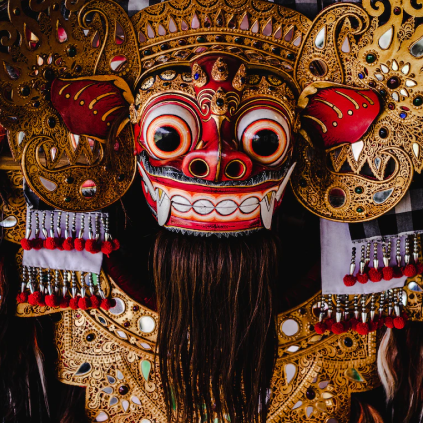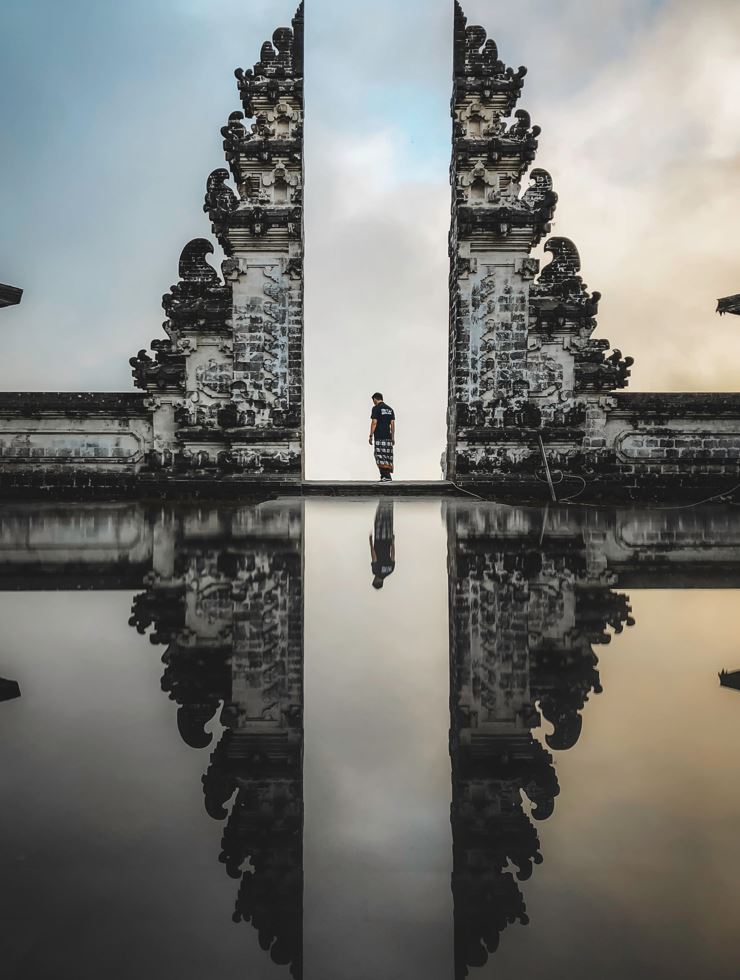
Bali
Bali, the famed Island of the Gods, with its varied landscape of hills and mountains, rugged coastlines and sandy beaches, lush rice terraces, and volcanic hillsides all providing a picturesque backdrop to its colorful, deeply spiritual, and unique culture stakes a serious claim to be paradise on earth.

Some Bali Travel Highlights
- Uluwatu Temple: Witness a mesmerizing Kecak dance performance against the backdrop of the Uluwatu Temple, perched on cliffs overlooking the Indian Ocean.
- Mount Batur Sunrise Trek: Embark on a predawn trek to the summit of Mount Batur and watch the sunrise over the caldera, a truly awe-inspiring experience.
- Ubud’s Artistic Enclave: Explore the art galleries, museums, and craft villages in Ubud, where you can witness Balinese artistry up close.
- Watersports: Whether a verteran or a first time water-sports enthusiast, Bali is a great place to partake in surfing, kite-boarding, SCUBA diving and Jet Skiing (try the Nusa Penida Express!).
- Sacred Monkey Forest Sanctuary: Interact with playful macaques in the lush Monkey Forest of Ubud while exploring ancient temple ruins.
- Tegallalang Rice Terraces: Marvel at the intricate and verdant rice terraces in Tegallalang, a testament to the Balinese agricultural heritage.
- Bali’s Underwater World: Dive or snorkel in the crystal-clear waters of Nusa Penida to encounter manta rays, vibrant coral gardens, and elusive ocean sunfish (Mola Mola).
- Balinese Cuisine: Delight in a culinary journey through Balinese cuisine, savoring dishes like babi guling (suckling pig) and nasi goreng (fried rice) at upscale restaurants or traditional warungs
- Water Temples of Bali: Explore the mystical water temples such as Tirta Empul, where you can partake in a traditional purification ritual.
- Luxury Beach Resorts: Enjoy the opulent comforts of Bali’s luxury beachfront resorts, offering world-class spa treatments, private villas, and gourmet dining.
- Bali’s Wellness Retreats: Indulge in rejuvenating spa treatments, yoga, and meditation at one of Bali’s renowned wellness retreats, set in tranquil natural surroundings.
Explore and enjoy the diverse culture, nature and uniqueness of Bali
Garuda Wisnu Kencana
Pantai Klingking
Kelingking: Where cliffs kiss white sand, and queues kiss photo ops. Prepare for paradise, with a dash of patience.
Lempuyang Temple
Ulundanu Temple
Topography and Geology
Bali’s topography is a mesmerizing blend of dramatic landscapes, ranging from towering volcanic peaks to pristine beaches. At the heart of the island stands the mighty Mount Agung, an active stratovolcano that looms at 3,031 meters (9,944 feet) above sea level.
This geological wonder not only shapes the island’s topography but also holds significant cultural and spiritual importance to the Balinese people. The island’s fertile soil owes its richness to volcanic activity, making Bali an agricultural haven.
Verdant terraced rice fields, swaying coconut palms, and tropical forests dominate the lowlands, while the coastline is fringed with picturesque beaches, some with pristine white sands, others with striking black volcanic sands. Bali’s geological diversity is further enhanced by its proximity to the Wallace Line, a biogeographical boundary that separates the flora and fauna of Asia and Australia.
As a result, the island boasts unique geological features and a rich biodiversity that make it a haven for nature enthusiasts.
Biodiversity
Bali’s biodiversity is a testament to the island’s unique ecological positioning. Its tropical climate and varied landscapes support a wide array of plant and animal species.
The lush rainforests are home to rare and endemic creatures like the Bali starling, a critically endangered bird found nowhere else in the world. The coral reefs surrounding the island offer a kaleidoscope of marine life, attracting divers and snorkelers from across the globe. In addition to its terrestrial and marine ecosystems, Bali’s rivers and wetlands provide habitats for diverse species, including exotic birds and amphibians.
The Bali myna, also known as the Bali starling, is perhaps the most famous of these endemic species and is considered a symbol of conservation efforts on the island. Bali’s rich biodiversity is not only a source of wonder but also integral to its culture.
The Balinese people have a deep spiritual connection with nature, and this reverence for the environment is evident in their daily rituals, art, and festivals.
Human History and Cultures
The history of Bali is as colorful as its landscapes. Archaeological evidence suggests human habitation on the island dating back to the early Holocene period.
Over the centuries, Bali has witnessed the rise and fall of various kingdoms, from the Majapahit Empire to Dutch colonial rule, each leaving its mark on the island’s culture and architecture. One of the most striking aspects of Bali’s culture is its Hindu-Balinese religion, a unique blend of Hinduism, animism, and Buddhism. The island is adorned with thousands of temples, from the iconic Uluwatu Temple perched on cliffs to the serene Besakih Temple on the slopes of Mount Agung.
These temples serve as centers of worship and are integral to the island’s cultural identity. Balinese culture is also celebrated through traditional dances and arts, such as the graceful Legong dance and the vibrant Barong dance.
Visitors can witness these performances at local villages and cultural centers, gaining insight into the island’s rich artistic heritage.
Ask us to design, curate and deliver a first class, unforgettable Indonesian Experience
Photo courtesy and copyright of Rob Collins
